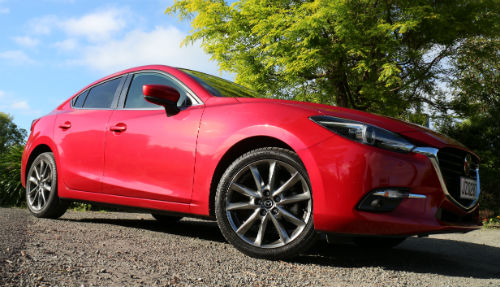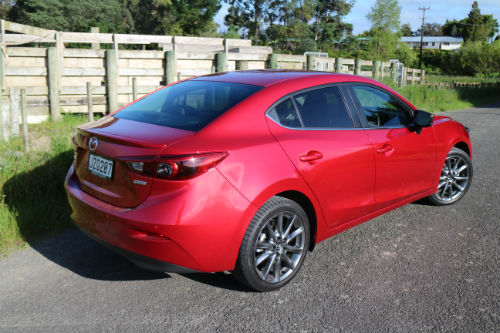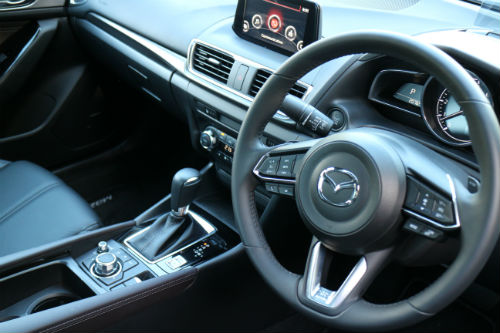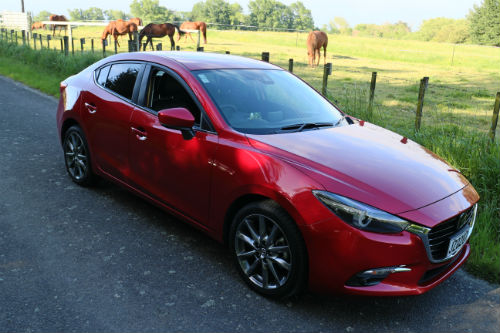Monday January 9, 2017
For: More safety equipment than key rivals and some premium cars in much higher price brackets, improved refinement, enjoyable to drive.
Against: MZD Connect tardiness, tight rear seat and small boot.
By Richard Bosselman
THE compact car category is an interesting sector – there’s one untouchable kingpin and a host of other alternates, some of which would probably better deserve the class crown.
There’s a simple reason why nothing gets close to the Toyota Corolla. An impressive fleet penetration ensures the oldest nameplate out of Japan Inc’s biggest brand outsells everything else in its zone by at least two to one.
But does being the country’s best-selling small (or should that be compact?) car necessarily makes it the national favourite?
Some would argue the Mazda3 is far more deserving of that accolade.
The Hiroshima privateer marque has been the rising hero of a buoyant new car sales scene. It does particularly well out of those car buyers who cannot charge back to a company account; penetration with private buyers is impressive and has been steadily rising over the past two years. Though the CX-badged sports utilities are selling strongest, the more traditional passenger models are also doing their bit.
The Mazda3 clearly remains a product that Kiwis have a lot of time for, if at a personal than professional level. Though not unseen in rep-dom, it predominantly sells to private buyers and is tailored accordingly. The latest generation car expresses strongly in respect to comfort, safety, finishing and efficiency. The dedication to those aspects were recognised with it achieving the New Zealand Motoring Writers’ Guild Car of the Year within its first year of sale.
Three years into service, a car that wasted no time imprinting positively with the market has been meted a mid-life facelift that further sharpens its already huge appeal.
While the SkyActiv technology and Kodo ‘Soul of Motion’ styling remain highly relevant, some suspension and steering retuning and the addition of extra driver assistance technology to the already well-stocked i-Activesense armoury are key revisions.
The addition of a G-force torque vectoring tech is a headline act, but equally more important and potentially more rewarding for everyday driving is that the Advanced Smart City Brake Support-Forward function now spreads from the top-level SP editions to the volume selling GLX and GSX models. This allows Mazda the enviable position of being the first mainstream brand to present, across its range, a low speed autonomous emergency braking solution with pedestrian recognition.
And all this for no change whatsoever to pricing – how good is that? Even though it carries a hefty $47,495 price tag, that’s a question the range-topping SP25 Limited was untroubled answering positively.
Design
A refresh that stops short of revision to major body panels could hardly be called a facelift. Yet, even though the exterior changes are subtle and almost wholly cosmetic, the degree of alteration is extensive enough to pass muster under a quick glance evaluation.
There’s no harm in Mazda having left its major metalwork alone; the flame-surfaced Kodo look has stood the test of time and is as handsome today as it was when fully fresh. The improvements to detailing make a good job even better. A slightly revised grille treatment has the Mazda symbol positioned lower while the signature "wing" motif is more prominent. The front indicators are integrated into the chrome fog-lamp bezels and the front and rear bumpers have a slightly changed profile. As said, it’s all a matter of detail changes, but the overall effect is to give a freshened air and impression of a widened stance.
For SP25 and SP25 Limited models there is rear privacy glass and 18-inch dark gloss alloy wheels and the SP25 Limited gains new LED adaptive headlamps that are 20 percent brighter than the cheaper alternates’ halogen jobs. The LED lamps also have a fancy auto high-beam function that rarely, if ever, gets caught out, even on darkest, muckiest nights.
Changes inside the cabin are more substantial. There’s a new and now leather-trimmed steering wheel, simplified instruments (the lowest grade still misses out on a digital speedo), and the USB points moved to an easier-to-situate location in the centre stack.
The handbrake … or, at least, the handbrake lever … has gone. Now every model has a switch-operated Electric Parking Brake. Is that an improvement? Well, I like handbrakes but, at the same time, appreciate that the new function is a step up; there’s no chance of driving around with the park brake activated and the new set up takes up a lot less room.
The SP models take a revised head-up display. The information layout is rejigged so data relating to the driving environment is displayed on the top half of the screen and information on the vehicle below. It’s still not a particularly premium- looking thing yet delivers marked improvement on the pre-facelift system. There’s not only more information but it is easier to read with upgraded colour, brightness, definition and contrast.
What about the toys? A base Mazda3 now comes with Bluetooth, manual air conditioning, cruise control, a six-speaker single-disc CD player with steering wheel controls, a seven inch colour-touchscreen central display, push-button start, and keyless entry.
The medium level GSX stands good chance of holding fast as the most popular choice variant. It seems rather well sorted with dual-zone climate AC, a leather steering wheel, SatNav, front fog lamps, auto headlights, rear parking sensors, Rear Cross Traffic Alert, proximity keyless entry, auto folding side mirrors, and auto wipers.
Why spend more? A lot of people won’t, but those who do generally cite one primary reason: They get to upgrade to the 2.5-litre engine. Mazda also guilds the lily by adding, for SP level, paddle shifters, 18 inch alloys, a rear spoiler, auto-dimming interior mirror, a 9-speaker 231-watt Bose audio system, the HUD, Driver Attention Alert, front parking sensors, and Traffic Sign Recognition.
The Limited thereafter adds the fancy headlamps (with DRLs), heated mirrors and front seats, an electric tilt/slide sunroof, leather seating, 10-way electric driver’s seat with two memory settings and electric lumbar adjustment, adaptive cruise, adaptive headlights, Forward Obstruction Alert, Lane Departure Warning, and Lane Keep Assist.
Some might quibble if all that is necessary, but realistically there’s nothing here than cannot be considered useful leaves it as loaded as a mainstream model can possibly be. Bear in mind that this generation Three became the first mainstream Japanese model to take a leaf from the European book of active and passive safety measure applications – three years on it still leads the way.
Powertrain
By maintaining a 2.5-litre four-cylinder petrol engine, Mazda is flying in the face of convention. Most rivals are downsizing with small displacement, often turbocharged engines. But it’s understandable why there’s reluctance to drop this unit: It sells well, provides a point of difference and isn’t too much of a burden to keep in respect to running costs.
The outputs of 138kW of power, peaking at 5700rpm, and 250Nm of torque (at 3250rpm), are not startling enough to make it feel dramatically muscular, but certainly give it an edge over the 2.0-litre, which gives 24kW and – more importantly - 50Nm less, especially if you drive it with verve.
Actually, that’s mandatory. Those who soft-foot this unit might as well stay with the smaller engine, a pretty decent unit also but enabled more readily to a laidback style, whereas the deeper-chested 2.5 demands – and appreciates – being given a few revs.
Don’t worry that Mazda only offers this engine in marriage with an automatic. The six-speed is designed to be playful; simply snip it into the Sport mode and thereafter jolly it along, as and when required, with the handshifters. Not that you need to provoke the gear changes. A mode designed to allow the powertrain to rev more freely is also smart enough to know exactly when shift up – or down. It’ll even blip on the downshifts, which are sometimes quite aggressive, and though not outright sporty in exhaust note, still occasions a decent rasp.
The get-up-and-go diminishes greatly when the box is driven in its standard setting. Indeed, the whole drivetrain settles down into less exuberant behaviour. It’s a smoother, quieter car then, but also a bit less characterful.
On the other hand, it does promise to be more economical and is clearly the only pathway to matching the make’s claimed optimum economy of 6.1 litres per 100km. An overall burn rate of 8.7L/100km for my test time betrayed that I clearly spent too much time in Sport, but I’d argue even that kind of economy is hardly going to make it a ban-buster, right?
Experience
THE SP is racier than the mainstream models but it doesn’t set out to be a substitute for the MPS hot hatch edition that has long departed the scene. Calling it a semi-sporty car is not slap in the face, however; the chassis has great delicacy and balance, the steering provides decent feel and while the engine doesn’t lack for enthusiasm, even if it demurs at smoking the tyres at every opportunity.
The update brings some significant development, not least that much-touted G-Vectoring Control which the maker says brings a dialogue between engine and chassis to steady the car in corners, generating what amounts to a degree of proactive self-steering.
That alone should make a big difference yet, initially, what captivates with the facelift is something else entirely. The one bugbear of this generation car was how much it suffered from in-cabin noise; obviously, being subjected to our particularly harsh coarse chip roads didn’t help in this respect (and you can hardly blame Mazda for feeling helpless to overcome that issue – because wholly quelling its effect seems beyond any brand) but, at the same time it did seem to be less capable than some category rivals.
Mazda attests to having enabled extra sound-proofing this time around, including with the implementation of some acoustic glass, but still sticks with low-profile 215/45 rubber, so conceivably there’s give and there’s take. So how it’s now? Simply, markedly better. Not quite to ‘cone of silence’ level but nonetheless it is more likeable.
Another improvement is with ride comfort. The suspension remains firm but is less jittery and brittle; we found good fluidity over rumpled surfaces that have been less than kind to some others in this category. And what you gain in compliance isn’t lost in cornering composure, either. For sure, there’s some pitch and dive under brakes and acceleration, but it’s a decent handler in the main, employing those 18-inch tyres to good effect. Mind you, we said the same about its predecessor. That it retains something of a fun aspect is worthwhile, given how significantly and dangerously some other brands have diluted their performance pedigrees, but given the brand’s ‘zoom-zoom’ ambition, it probably has to be this way.
What effect those aidess? GVC is patently the ‘right’ kind of thing, but the merits that came across coherently during my first taster – a carefully controlled exercise on a circuit – were simply not as obvious for road driving; basically, you’ll be pushing to notice it. But, then, Mazda itself says this setup is designed to be subtle, so perhaps no surprise there.
More immediately beneficial is the autonomous emergency braking (AEB) – which is standard across the model range. A system set up to stop the car if it ‘thinks’ you won’t is brilliantly intuitive and really useful, because it also works in reverse, when you can call upon a rear cross-traffic alert as well. That Mazda has provisioned the Three with this technology is a major plus. These are items that aren’t standard in some far pricier and swankier price.
The lane departure warning can be a bit of a worry wart but it’s not overly intensive when it gives the steering wheel a nudge back into the lane if it thinks you need it and the Blind Spot Monitoring is a useful assist.
Weaknesses? There are a lot of buttons and some potentially aren’t as well located as you’d think, though perhaps it’s been a matter of just putting them where they can fit. Also, while Mazda’s MZD Connect system with a 7.0-inch screen that’s touch-capacitive at standstill and otherwise operated by a rotary dial interface is a solid piece of sensible design, the brains that drive it do seem a bit slow. For instance, should you start the car and select reverse sometimes the camera requires a second or two to log on. The biggest delay can be with the navigation; it took a while to sort itself – twice, in fact, it failed to load up at all and only remedied when the ignition was turned off, then back on again. The old car had similar issues.
The basic drawback with the Mazda3 is one that will only be remedied with the next generation. Essentially, this version (like the last) takes the compact definition a little too seriously, at least insofar as rear seat and boot space goes. The only occupants who won’t complain about limited leg room are front seat passengers. Knee and head room is the back is much tighter. The hatch’s boot space is also quite small, giving away 100 litres’ capacity to the sedan. That might be more of an issue for the lower echelon variants, which potentially stand greater chance of being used as full family fare, than with the SP models which, despite their sporty ambience, are in the main bought by empty-nester couples.
Verdict
Even if the best-equipped, most prestigious Mazda3 model on sale will seem too rich for many buyers, it’s hardly fair to suggest it is overly-embellished for class consideration. Consider this variant a family pathfinder; there’s every chance all the equipment exclusive to the flagship today might well reach the whole of tomorrow’s lineup. And, in current form, it presents as the tastiest mainstream Japanese alternate to a host of junior premium cars.


